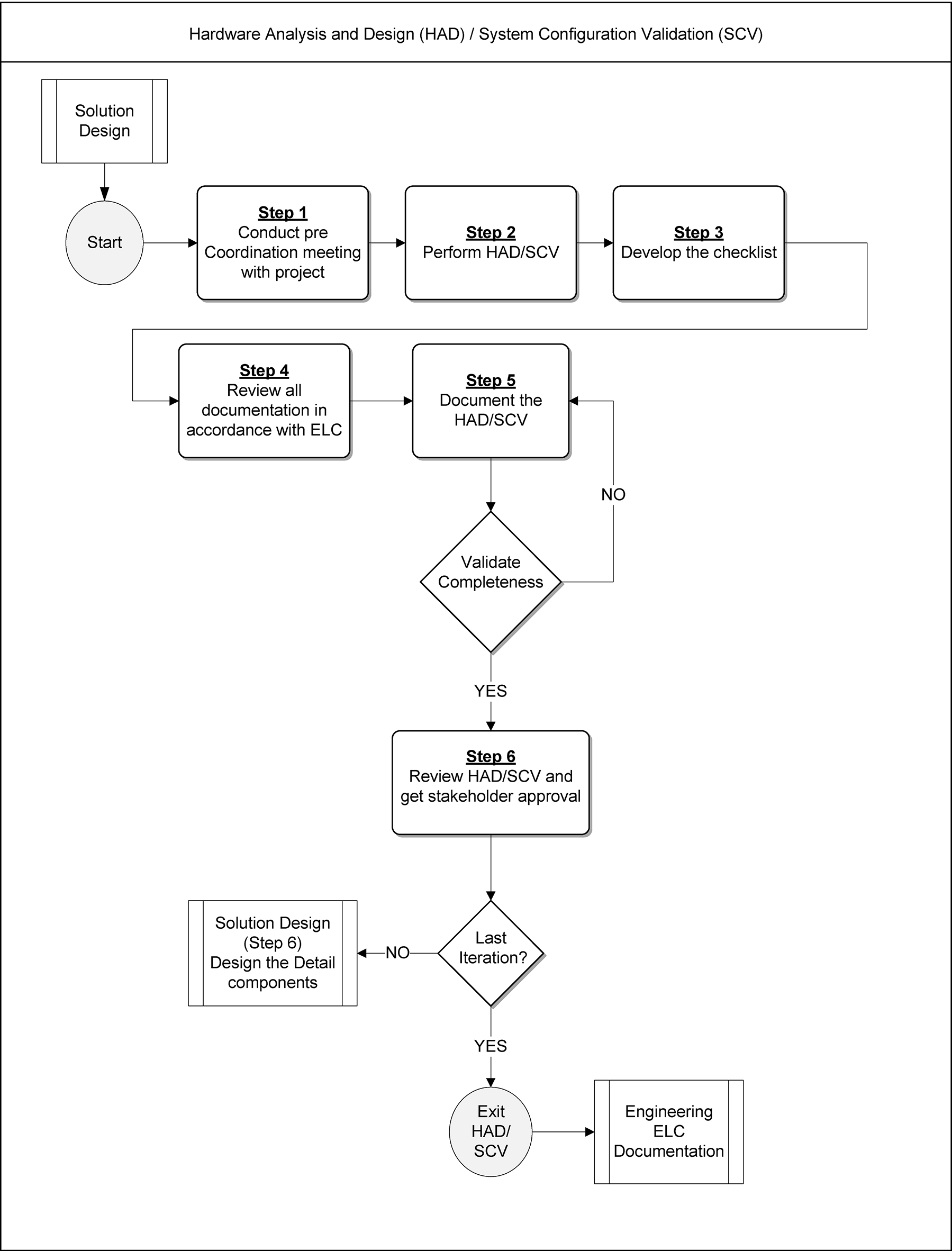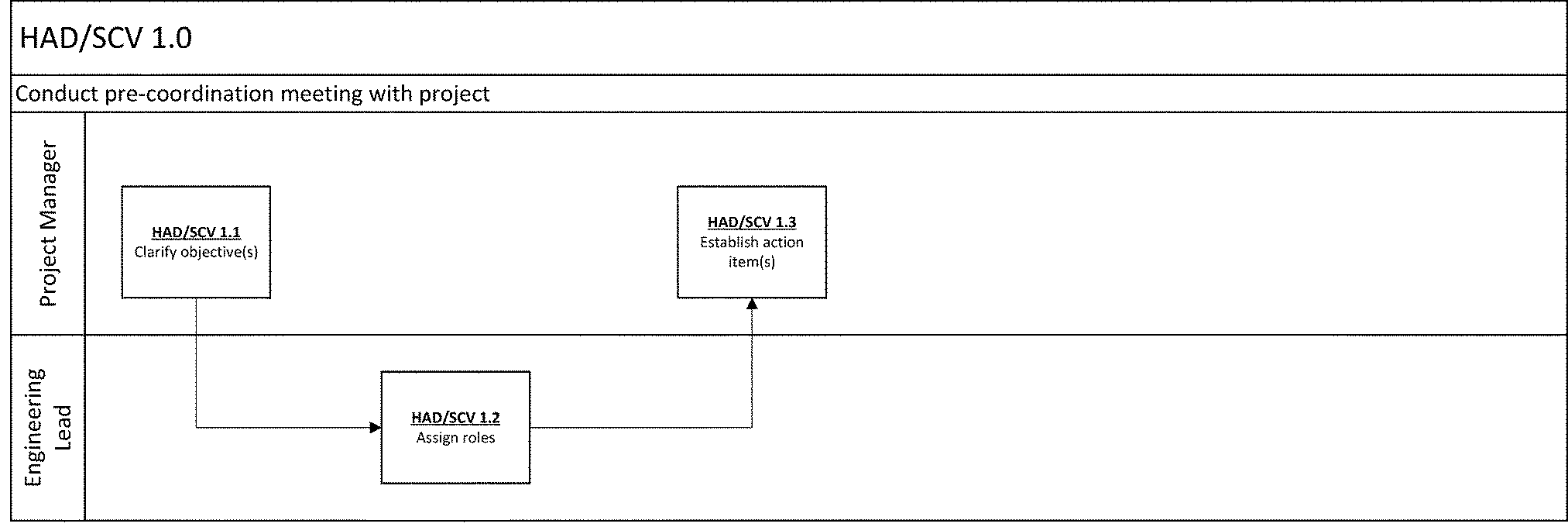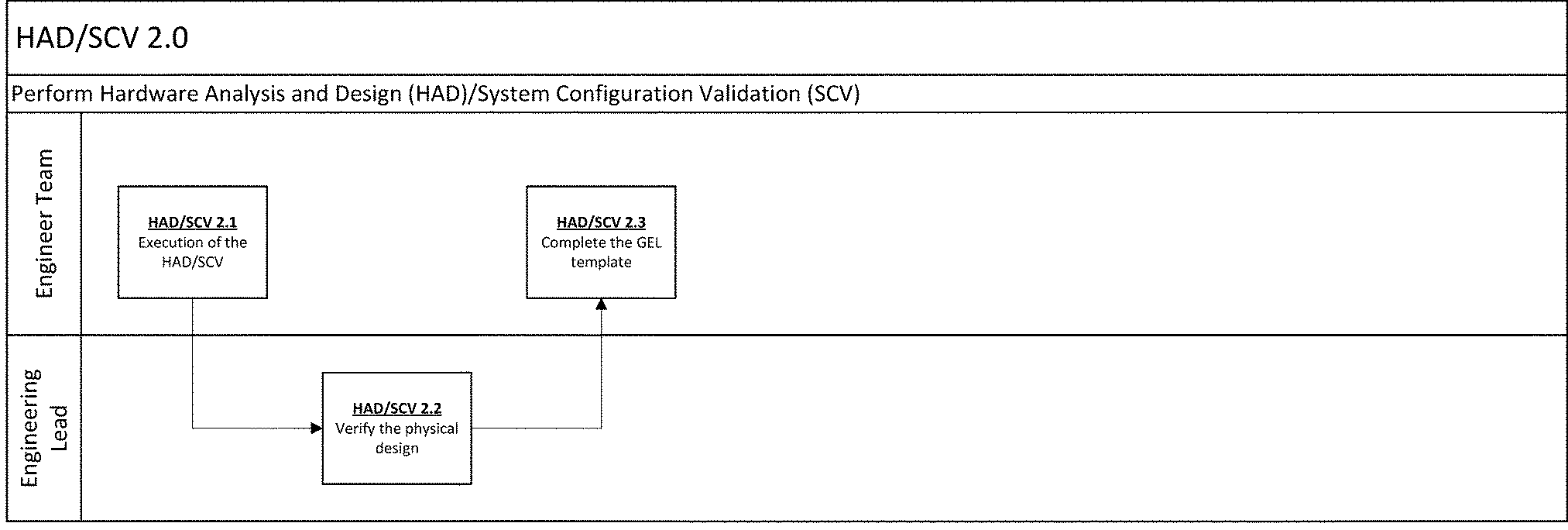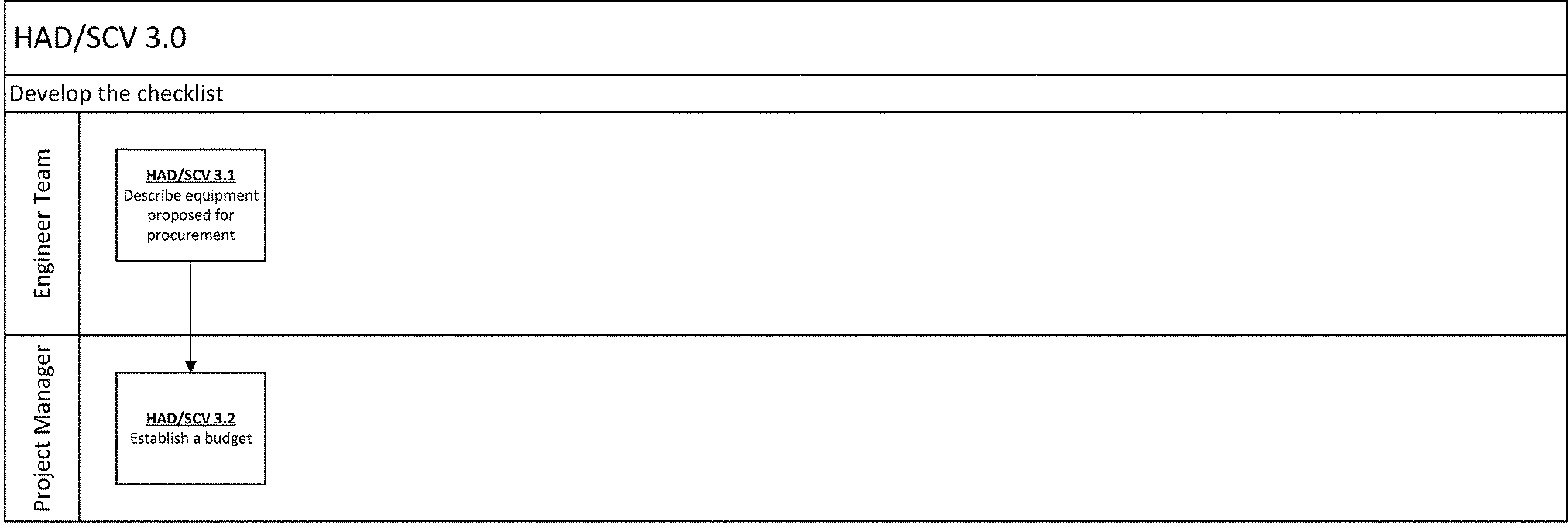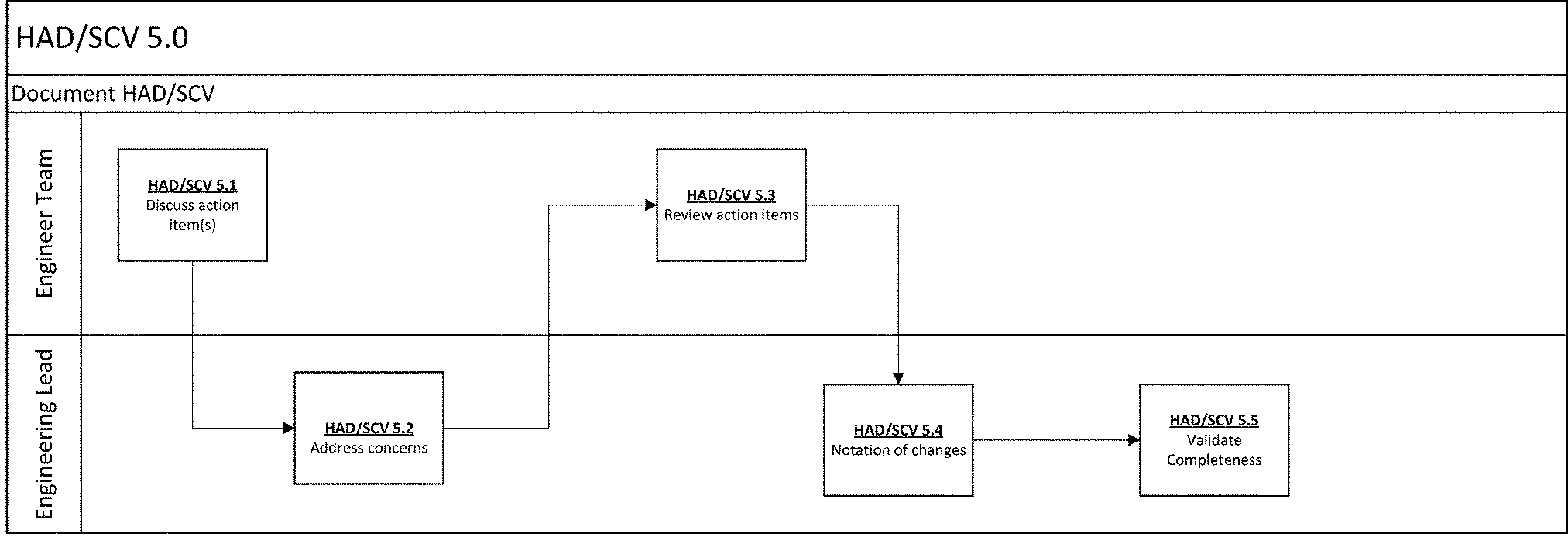- 2.120.9 Hardware Analysis and Design (HAD) /System Configuration Validation (SCV) Process
- 2.120.9.1 Program Scope and Objectives
- 2.120.9.1.1 Background
- 2.120.9.1.1.1 Process Description
- 2.120.9.1.1.2 Goal
- 2.120.9.1.1.3 Objectives
- 2.120.9.1.2 Authority
- 2.120.9.1.3 Roles and Responsibilities
- 2.120.9.1.4 Program Management and Review
- 2.120.9.1.5 Program Control
- 2.120.9.1.5.1 Controls
- 2.120.9.1.5.2 Metrics
- 2.120.9.1.5.3 Tailoring Guidelines
- 2.120.9.1.5.4 Quality Assurance
- 2.120.9.1.6 Terms/Definitions/Acronyms
- 2.120.9.1.6.1 Terms and Definitions
- 2.120.9.1.6.2 Acronyms
- 2.120.9.1.7 Related Resources
- 2.120.9.1.8 Training
- 2.120.9.1.1 Background
- 2.120.9.2 Process Workflow
- 2.120.9.2.1 Main Process Diagram
- 2.120.9.2.2 Inputs
- 2.120.9.2.3 Outputs
- 2.120.9.2.4 Activities
- 2.120.9.2.5 Procedure
- 2.120.9.2.5.1 HAD/SCV 1.0: Conduct pre-coordination meeting with project
- 2.120.9.2.5.2 Cross-Functional Flow Diagram
- 2.120.9.2.5.3 HAD/SCV 2.0 Perform HAD/SCV
- 2.120.9.2.5.4 Cross-Functional Flow Diagram
- 2.120.9.2.5.5 HAD/SCV 3.0 Develop the checklist
- 2.120.9.2.5.6 Cross-Functional Process Flow Diagram
- 2.120.9.2.5.7 HAD/SCV 4.0 Review all documentation in accordance with One Solution Delivery Lifecycel(OneSDLC
- 2.120.9.2.5.8 Cross-Functional Flow Diagram
- 2.120.9.2.5.9 HAD/SCV 5.0 Document HAD/SCV
- 2.120.9.2.5.10 Cross-Functional Flow Diagram
- 2.120.9.2.5.11 HAD/SCV 6.0 Review HAD/SCV and get stakeholder approval
- 2.120.9.2.5.12 Cross-Functional Flow Diagram
- 2.120.9.1 Program Scope and Objectives
Part 2. Information Technology
Chapter 120. Engineering
Section 9. Hardware Analysis and Design (HAD) /System Configuration Validation (SCV) Process
2.120.9 Hardware Analysis and Design (HAD) /System Configuration Validation (SCV) Process
Manual Transmittal
May 29, 2024
Purpose
(1) This transmits revises IRM 2.120.9 Hardware Analysis and Design (HAD)/System Configuration Validation (SCV) dated January 29, 2024 due to OneSDLC compliance.
Material Changes
(1) Making changes to IRM to be OneSDLC Compliant.
Effect on Other Documents
IRM 2.120.9 Hardware Analysis and Design (HAD)/System Configuration Validation (SCV) dated January 13, 2023 is superseded.Audience
The design process is applicable to all One Solution Delivery Lifecycle(OneSDLC) projects, Information Technology (IT) organizations, contractors, and other stakeholders having responsibility for Hardware Analysis and Design (HAD)/System Configuration Validation (SCV) activities.Effective Date
(05-29-2024)
Rajiv Uppal
Chief Information Officer
-
Overview - This IRM describes the formal process implementing the requirements of the Hardware Analysis and Design (HAD) /System Configuration Validation (SCV), specifies steps and procedural tasks that all IT projects need to complete the design phase.
-
Purpose - This IRM contains procedural steps to successfully select hardware/software for projects.
-
Audience - This process description is applicable to all One Solution Delivery Lifecycle(OneSDLC) projects, Information Technology (IT) organizations, contractors, and other stakeholders having responsibility for hardware and software design activities.
-
Policy Owner - The Associate Chief Information Officer (ACIO), Enterprise Services.
-
Program Owner - Solution Engineering Division (SE), which is under the Information Technology (IT), Enterprise Services (ES).
-
Primary Stakeholders - Information Technology project team members are the primary stakeholders for the Hardware Analysis and Design (HAD)/Service Configuration Validation (SCV).
-
Program Goals - The Program goals of the Hardware Analysis and Design (HAD)/ Service Configuration Validation (SCV) process is to have all related design work documented during the design phase.
.
-
A process is defined as “A set of related activities that accomplish a common goal”. The process definition laid out in this document divides these activities into tasks, each of which have a complete set of attributes defined such as data, tool specifications and the role(s) responsible for executing the tasks. The document also includes process goal and objectives, metrics, role definitions, policies and other process related attributes.
-
The Hardware Analysis and Design (HAD)/System Configuration Validation (SCV) process describes the activities required to produce the content that is documented within the Government Equipment List (GEL) and provides the operational definition of the major components within the designs. This description specifies, in a complete, precise and verifiable manner, the requirements, design and behavioral characteristics of the HAD/SCV process. The HAD/SCV Process Description is a documented expression of a set of activities performed to achieve a given purpose.
-
The process goal describes a specific purpose or achievement toward which the efforts of the process are directed. Each process has a specific focus and when combined with the other processes, forms a comprehensive framework for delivering and managing services.
GELs developed through the HAD/SCV process are reviewed by Solution Engineering, contain all the information required during the acquisitions process and are submitted timely.
-
Process objectives describe material outcomes that are produced or achieved by the process. The following is a list of objectives for this process:
-
Minimize the time to acquire equipment for project needs
-
Provide an accurate understanding of the actions required by projects to more efficiently support the One Soluion Delivery Lifecycle(OneSDLC)
-
-
All proposed changes to this document must be submitted in writing, with supporting rationale, to the Enterprise Services, Solution Engineering, Process Maturity branch.
-
Each process defines at least one role. Each role is assigned to perform specific tasks within the process. The responsibilities of a role are confined to the specific process. They do not imply any functional standing within the hierarchy of an organization. For example, the Process Manager role does not imply the role is associated with or fulfilled by someone with functional management responsibilities within the organization. Within a specific process, there can be more than one individual associated with a specific role. Additionally, a single individual can assume more than one role within the process although typically not at the same time. Many roles are involved in the HAD/SCV process. This section defines the roles used throughout this document in terms of their responsibilities.
Role Description Definition of Responsibility Engineering Lead -
Reviews the Change Authority’s decision, annotates acceptance or rejection of the decision, and returns the updated request for change
-
Originate HAD/SCV content for submission
Engineering Team -
Completes the verification steps
Project Manager -
Verify the HAD/SCV document meets technological requirements
-
-
Policies outline a set of plans or courses of action that are intended to influence and determine decisions or actions of a process. Policies provide an element of governance over the process that provides alignment to business vision, mission and goals.
Process Management Statement: The HAD/SCV process will have a single Process Owner and a separate Process Manager responsible for implementation and ensuring adherence to the process. The process will be reviewed regularly to ensure that it continues to support the business requirements of the enterprise. The process will be designed and developed based on return on investment (ROI) to the organization. Process metrics will be focused on providing relevant information as opposed to merely presenting raw data. People: Statement: Roles and responsibilities for the process must be clearly defined and appropriately staffed with people having the required skills and training. The mission, goals, scope and importance of the process must be clearly communicated by upper management to the staff and business customers of IT. All IT staff (direct and indirect users of the process) shall be trained at the appropriate level to enable them to support the process. Rationale: It is imperative that people working in, supporting or interacting with the process in any manner understand what they are supposed to do. Without that understanding HAD/SCV will not be successful. Process: Statement: Modifications to the HAD/SCV process must be approved by the Process Owner. The design of the process must include appropriate interfaces with other processes to facilitate data sharing, escalation and workflow. The process must be capable of providing data to support real-time requirements as well as historical/trending data for overall process improvement initiatives. The process must be fully documented, published and accessible to the various stakeholders of the process. The process will be reviewed on a periodic basis in order to ensure it continues to support organizational goals and objectives (continuous improvement). The process must include Inputs, Outputs, Controls, Metrics, Activities, Tasks, Roles and Responsibilities, Tool and Data requirements along with documented process flows. The process will be kept straight forward, rational, and easy to understand. Rationale: The process must meet operational and business requirements. Technology and Tools: Statement: All tools selected must conform to the enterprise architectural standards and direction. Existing in-house tools and technology will be used wherever possible, new tools will only be entertained if they satisfy a business need that cannot be met by current in-house tools. The selection of supporting tools must be process driven and based on the requirements of the business. Selected tools provide ease of deployment, customization and use. Automated workflow, notification and escalation will be deployed wherever possible to minimize delays, ensure consistency, reduce manual intervention and ensure appropriate parties are made aware of issues requiring their attention.
The tools used by this process are the following:-
HAD/SCV Template
-
Pre-Coordination Checklist
-
HAD/SCV waiver, if applicable
-
OneSDLC Checklist
Rationale: Technology and tools should be used to augment the process capabilities, not become an end themselves. -
-
Activities involved in ensuring a process is predictable, stable, and consistently operating at the target level of performance.
-
Process controls represent the policies and guiding principles on how the process will operate. Controls provide direction over the operation of processes and define constraints or boundaries within which the process must operate.
Name Description Engineering Policy (Directive) The project will include in its Engineering Plan either by inclusion or reference, planning materials specifying how the following will be accomplished: -
Execution Engineering Process
-
Obtaining needed resources to perform Engineering Process
-
Control of work products required by the Management Process
-
Engagement of stakeholders affected by the HAD/SCV Process
-
Monitoring and Controlling of the Management Process
-
Collection of Management Process measures
-
Review of Management Process Measures
-
Establishment of the Management Process within the project’s defined process
-
Submission of Lessons Learned and process improvement suggestions from the execution of Management Process
-
Recency of signature (every 3 years)
-
Annual reviews
Scope All projects will follow the Hardware Analysis and Design Software Configuration and Validation process to perform HAD/SCV and associate activities in accordance to this policy. -
-
Metrics are used for the quantitative and periodic assessment of a process. They should be associated with targets that are set based on specific business objectives. Metrics provide information related to the goals and objectives of a process and are used to take corrective action when desired results are not being achieved and can be used to drive continual improvement of process effectiveness and efficiency.
-
Management will regularly set targets for process performance, gather quantifiable data related to different functions of the HAD/SCV process, and review that data in order to make informed decisions and take appropriate corrective action, if necessary. All Measurements will have a defined data dictionary, map to the organizational strategic goals, and be documented in a Process Measurement Plan. The Process Measurement Plan template is available in the SE EPM SharePoint.
-
Terms/Definitions/Acronyms
-
Terms and Definitions
Term Definition Government Equipment List (GEL) A detailed list of the hardware and software equipment to be acquired. Cloud (GEL) A detailed list of the hardware, software and services to be acquired, and the Physical Design for the Cloud project. Cloud GEL is a type of the GEL.
-
Acronyms
Acronyms Description ACIO Assistant Chief Information Officer OneSDLC One Solution Delivery Lifecycle ITM Integrated Talent Management EOPs Enterprise Operations ES Enterprise Services GEL Government Equipment List IT Information Technology ITSM Information Technology Service Management PAL Process Asset Library SE Solution Engineer ROI Return on Investment
-
Process training involves training all stakeholders about key processes that are crucial for an organization to deliver business objectives. Training provides clarity to employees on a set of procedures that needs to be carried out as part of the process and the best possible way to do them.
-
A process workflow consists of Activities and Tasks, Inputs and Outputs, Roles, and Flow Diagrams. It describes the tasks, procedural steps, organizations or people involved, required input and output information, and tools needed for each step of the process.
-
Process inputs are used as triggers to initiate the process and to produce the desired outputs. Users, stakeholders or other processes provide inputs. The following is a list of inputs for this process:
Name Description Supplier Customer Service Request Customer service request via Enterprise Services Front Door (ESFD) Project Manager Funding Authorization Funding Data Strings Project Manager Simplified Design Specification Report (SDSR) Physical design specifications based on customer requirements Engineer(s)
-
Each process produces tangible outputs. These outputs can take the form of products or data and can be delivered to a user or stakeholder or they can be used as inputs to other processes. Outputs are measurable in terms of quantity and quality.
-
Completed GEL document.
-
-
An activity is a major unit of work to be completed in achieving the objectives of the process. A process consists of a sequence of related activities that transforms inputs into outputs and performed by the roles defined in the process. Activities are measurable in terms of efficiency and effectiveness. Identify the activities in the process and provide a brief description. The activities must correspond with the high-level process flow diagram above.
ID Name Description HAD/SCV 1.0 Conduct pre-coordination meeting with project -
Clarify objectives
-
Assign roles
-
Establish action items
HAD/SCV 2.0 Perform HAD/SCV -
Execution of the HAD/SCV
-
Verify the physical design
-
Complete the GEL template
HAD/SCV 3.0 Develop the checklist -
Describe equipment proposed for procurement
-
Establish a budget
HAD/SCV 4.0 Review all the documentation in accordance with the OneSDLC -
Disposition HAD/SCV
HAD/SCV 5.0 Document the HAD/SCV -
Discussion of each line item
-
Address any action item(s) presented
-
Review of action items to resolve
-
Notation of any changes
-
Validate completeness
HAD/SCV 6.0 Review the HAD/SCV and get approvals by all stakeholder(s) -
Review completed document for possible discrepancies
-
Circulate the completed document
-
-
Procedure
-
ID Task Name and Description Role RACI Duties HAD/SCV 1.1 Clarify objective(s) Project Manager R Ensure that design concept is clear and concise HAD/SCV 1.2 Assign roles Engineering Lead R Advise team members of their functional positions HAD/SCV 1.3 Establish action item(s) Project Manager R Determine specific needs to be met Note:
RACI is a responsibility matrix that describes the participation by various roles in completing the tasks or deliverables for a project or business process. RACI is derived from the four key responsibilities typically used:
-
Responsible – The person that is assigned to do the work
-
Accountable – The person that makes the final decision and has ultimate ownership.
-
Consulted – The person that must be consulted before a decision or action is taken.
-
Informed – The person that must be informed that a decision or action has been taken
-
-
ID Task Name and Description Role RACI Duties HAD/SCV 2.1 Execution of the HAD/SCV Engineering Team R Confirm the specific characteristics of the project HAD/SCV 2.2 Verify the physical design Engineering Lead R/A Project initiation begins HAD/SCV 2.3 Complete the GEL template Engineering Team R Finalization of the project Note:
*RACI is a responsibility matrix that describes the participation by various roles in completing the tasks or deliverables for a project or business process. RACI is derived from the four key responsibilities typically used:
-
Responsible – The person that is assigned to do the work.
-
Accountable – The person that makes the final decision and has ultimate ownership.
-
Consulted – The person that must be consulted before a decision or action is taken.
-
Informed – The person that must be informed that a decision or action has been taken.
-
-
ID Task Name and Description Role RACI Duties HAD/SCV 3.1 Describe equipment proposed for procurement Engineering Team R List the items needed and possible alternatives HAD/SCV 3.2 Establish a budget Project Manager R/A Finalize cost of the project Note:
*RACI is a responsibility matrix that describes the participation by various roles in completing the tasks or deliverables for a project or business process. RACI is derived from the four key responsibilities typically used:
-
Responsible – The person that is assigned to do the work.
-
Accountable – The person that makes the final decision and has ultimate ownership.
-
Consulted – The person that must be consulted before a decision or action is taken.
-
Informed – The person that must be informed that a decision or action has been taken
-
-
ID Task Name and Description Role RACI Duties HAD/SCV 4.1 Ensure documentation is in alignment with OneSDLC Project Manager R Forward the finalized GEL to customer Note:
*RACI is a responsibility matrix that describes the participation by various roles in completing the tasks or deliverables for a project or business process. RACI is derived from the four key responsibilities typically used:
-
Responsible – The person that is assigned to do the work.
-
Accountable – The person that makes the final decision and has ultimate ownership.
-
Consulted – The person that must be consulted before a decision or action is taken.
-
Informed – The person that must be informed that a decision or action has been taken.
-
-
ID Task Name and Description Role RACI Duties HAD/SCV 5.1 Discuss action item(s) Engineering Team R Analyze the recommended items HAD/SCV 5.2 Address concerns Engineering Lead R Clarify needs and discuss possible resolutions HAD/SCV 5.3 Review action item(s) Engineering Team R Ensuring that all concerns have been addressed and will be settled HAD/SCV 5.4 Notation of changes Engineering Lead R Documentation of possible alterations needed HAD/SCV 5.5 Validate Completeness Engineering Lead R Validating process steps 1-5 for completeness Note:
*RACI is a responsibility matrix that describes the participation by various roles in completing the tasks or deliverables for a project or business process. RACI is derived from the four key responsibilities typically used:
-
Responsible – The person that is assigned to do the work.
-
Accountable – The person that makes the final decision and has ultimate ownership.
-
Consulted – The person that must be consulted before a decision or action is taken.
-
Informed – The person that must be informed that a decision or action has been taken.
-
-
ID Task Name and Description Role RACI Duties HAD/SCV 6.1 Review completed document for discrepancies Engineering Lead R Ensure accuracy of information within GEL HAD/SCV 6.2 Solution Design Engineering Lead R Design detail components HAD/SCV 6.3 Circulate completed documentation Project Manager R/A Forward documentation to respective parties Note:
*RACI is a responsibility matrix that describes the participation by various roles in completing the tasks or deliverables for a project or business process. RACI is derived from the four key responsibilities typically used:
-
Responsible – The person that is assigned to do the work.
-
Accountable – The person that makes the final decision and has ultimate ownership.
-
Consulted – The person that must be consulted before a decision or action is taken.
-
Informed – The person that must be informed that a decision or action has been taken.
-

 )
or https:// means you've safely connected to the .gov website. Share sensitive information only on official, secure websites.
)
or https:// means you've safely connected to the .gov website. Share sensitive information only on official, secure websites.

